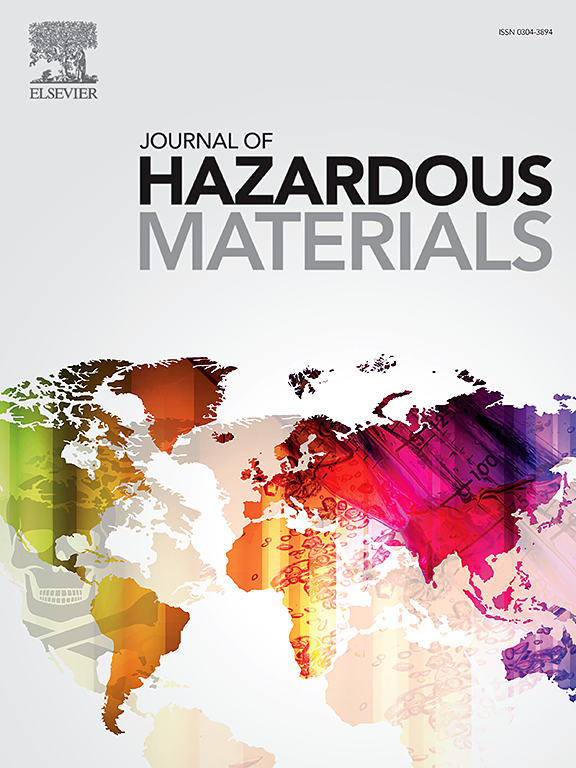一种具有同时生物降解聚苯乙烯微塑料和杀菌剂多菌灵能力的新型velezensis菌株
IF 12.2
1区 环境科学与生态学
Q1 ENGINEERING, ENVIRONMENTAL
引用次数: 0
摘要
本研究从微塑料和杀菌剂多菌灵严重污染的土壤中分离到一株既能降解聚苯乙烯(PS)微塑料又能降解多菌灵的新菌株M1,经鉴定为velezensis芽孢杆菌。在60天的培养期内,对单一污染物的降解实验表明,在1000 mg/L的浓度下,菌株对PS微塑料的质量还原效率为10.8±0.95%,对多菌灵的质量还原效率为56.64±0.60%。值得注意的是,在两种污染物(各1000 mg/L)共暴露条件下,PS微塑料的质量还原效率分别为6.60±0.85%和34.70±2.52%。经过60天的生物降解,扫描电镜(SEM)、水接触角(WCA)、高温凝胶色谱(GPC)、傅里叶变换红外光谱(FTIR)和热重分析(TGA)证实了细菌M1在不同条件下对PS微塑料的生物降解。通过高效液相色谱(HPLC)、扫描电镜(SEM)和傅里叶变换红外光谱(FTIR)分析,证实了细菌在不同条件下对多菌灵的生物降解作用。本研究首次报道了一种能够同时降解PS微塑料和多菌灵的新型菌株,为解决环境中复合有机污染提供了新的途径。本文章由计算机程序翻译,如有差异,请以英文原文为准。

A novel Bacillus velezensis strain with the ability to simultaneously biodegrade polystyrene microplastics and fungicide carbendazim
In this study, a novel bacterial strain, M1, capable of degrading both polystyrene (PS) microplastics and carbendazim, was isolated from soil heavily contaminated with microplastics and fungicide carbendazim, and was identified and determined to be Bacillus velezensis. During the 60-day cultivation period, degradation experiments with single pollutants demonstrated that, at a concentration of 1000 mg/L, the strain achieved mass reduction efficiency of 10.8 ± 0.95 % for PS microplastics and 56.64 ± 0.60 % for carbendazim. Remarkably, under co-exposure conditions with both pollutants (1000 mg/L each), attaining mass reduction efficiency of 6.60 ± 0.85 % for PS microplastics and 34.70 ± 2.52 % for carbendazim respectively. After 60 days of biodegradation, scanning electron microscopy (SEM), water contact angle (WCA), high-temperature gel chromatography (GPC), Fourier transform infrared spectroscopy (FTIR), and thermogravimetric analysis (TGA) confirmed the biodegradation of PS microplastics by Bacterium M1 under different conditions. The biodegradation of carbendazim by bacteria under different conditions was confirmed by high performance liquid chromatography (HPLC), scanning electron microscopy (SEM), and Fourier transform infrared spectroscopy (FTIR) analyses. This study reports for the first time a novel bacterial strain capable of simultaneous degradation of both PS microplastics and carbendazim, providing a new approach to address composite organic pollution in the environment.
求助全文
通过发布文献求助,成功后即可免费获取论文全文。
去求助
来源期刊

Journal of Hazardous Materials
工程技术-工程:环境
CiteScore
25.40
自引率
5.90%
发文量
3059
审稿时长
58 days
期刊介绍:
The Journal of Hazardous Materials serves as a global platform for promoting cutting-edge research in the field of Environmental Science and Engineering. Our publication features a wide range of articles, including full-length research papers, review articles, and perspectives, with the aim of enhancing our understanding of the dangers and risks associated with various materials concerning public health and the environment. It is important to note that the term "environmental contaminants" refers specifically to substances that pose hazardous effects through contamination, while excluding those that do not have such impacts on the environment or human health. Moreover, we emphasize the distinction between wastes and hazardous materials in order to provide further clarity on the scope of the journal. We have a keen interest in exploring specific compounds and microbial agents that have adverse effects on the environment.
 求助内容:
求助内容: 应助结果提醒方式:
应助结果提醒方式:


